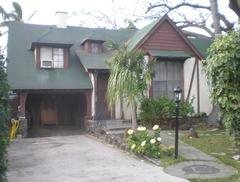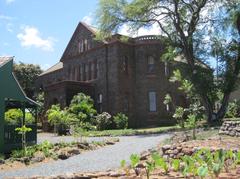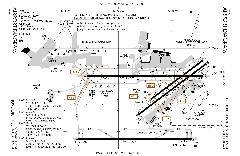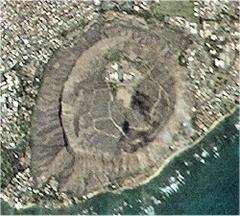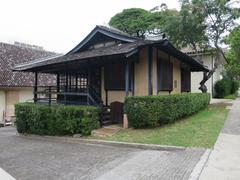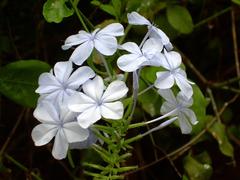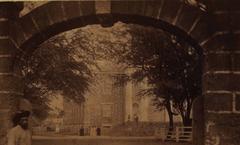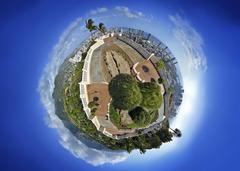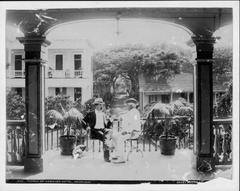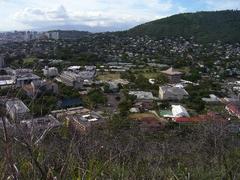Waʻahila Ridge State Recreation Area: Visiting Hours, Tickets, and Travel Guide
Date: 14/06/2025
Introduction
Waʻahila Ridge State Recreation Area is a unique destination nestled between the Mānoa and Pālolo valleys on Oʻahu, Hawaiʻi. Bridging natural wonder with deep cultural roots, this scenic ridge—part of the Koʻolau Mountain Range—offers panoramic vistas, hiking adventures, and a living connection to ancient Hawaiian traditions. Visitors can explore evidence of early agricultural ingenuity, enjoy native forest habitats, and experience the Hawaiian value of mālama ʻāina (caring for the land). With accessible facilities, free admission, and thoughtfully maintained trails, Waʻahila Ridge is a must-visit for history buffs, nature lovers, and outdoor enthusiasts alike (Hawaii State Parks).
Contents
- History, Cultural Significance, and Ancient Land Use
- Natural Features and Biodiversity
- Visiting Hours, Tickets, and Access
- Unique Experiences and Nearby Attractions
- Educational and Interpretive Resources
- Community Stewardship and Conservation
- Practical Visitor Tips
- Frequently Asked Questions (FAQ)
- Plan Your Visit and Related Resources
History, Cultural Significance, and Ancient Land Use
Ancient Hawaiian Connections
Waʻahila Ridge is much more than a scenic park—it is a landscape woven into the history and culture of Hawaiʻi. The area is home to remnants of ancient loʻi (taro terraces), a testament to the sophisticated agricultural systems developed by early Hawaiians. These terraces supported local communities and reflected a sustainable relationship with the ʻāina (Hawaii State Parks).
The ridge’s strategic location between Mānoa and Pālolo valleys made it an important corridor for both resource gathering and ceremonial purposes. Oral histories and archaeology suggest a rich history of subsistence and spiritual practice, with ancient features serving as a tangible link to the past (Verdant Traveler).
Cultural and Spiritual Resonance
Ridges and mountain passes in Hawaiʻi are often steeped in moʻolelo (stories) and legends. Although specific legends about Waʻahila Ridge are less widely known, the site’s prominence in the landscape and its proximity to significant valleys mark it as a place of cultural importance. The practice of mālama ʻāina underpins the park’s preservation, with interpretive signage and educational materials encouraging visitors to engage respectfully with the land (Verdant Traveler).
Historical Evolution and Preservation
Waʻahila Ridge underwent significant changes during the plantation era, including the introduction of non-native plant species. The transition to a state recreation area in the latter 20th century reflects a commitment to both conservation and public enjoyment. Today, park management balances recreation, education, and preservation to safeguard this landscape for future generations (Hawaii State Parks).
Natural Features and Biodiversity
Topography and Geology
Situated along a prominent finger ridge of the Koʻolau Mountain Range, Waʻahila Ridge rises to approximately 1,600 feet (488 meters) above sea level. The ridge’s volcanic origins and subsequent erosion have created undulating terrain, steep drop-offs, and narrow saddles, making it a distinctive landscape within easy reach of Honolulu (The Hiking HI).
Vegetation and Plant Communities
Native Forest Remnants
Patches of native Hawaiian forest—featuring koa and ʻōhiʻa lehua—provide vital habitat for endemic wildlife. The understory includes ferns such as palapalai and shrubs like ʻōhelo and pukiawe. Mosses and lichens thrive in the shaded, moist microclimates of the ridge.
Invasive and Introduced Species
Much of the ridge is dominated by introduced trees, including Cook pine and ironwood, planted for erosion control. Invasive plants like guava and strawberry guava also compete with native flora. Regular maintenance and restoration efforts aim to preserve native plant communities (Waahila Ridge SRA Park Improvements).
Wildlife
Native Birds
Native honeycreepers such as the ʻapapane and ʻamakihi frequent the area, feeding on nectar from ʻōhiʻa lehua blossoms. The pueo (Hawaiian owl) is occasionally spotted at dawn or dusk.
Introduced Birds and Mammals
Common birds include the Japanese white-eye, red-billed leiothrix, and spotted dove. Feral pigs, mongoose, and rats—introduced mammals—pose threats to native species.
Scenic Vistas and Natural Landmarks
The ridge offers breathtaking views of Honolulu, Diamond Head, Mānoa Valley, and the windward coast. Exposed basalt outcrops and a mosaic of plant communities create a dynamic environment, especially striking in the interplay of sun, clouds, and mist (The Hiking HI).
Trail Features and Microhabitats
The main Waʻahila Ridge Trail (2.4 miles one-way) traverses a range of habitats, from shaded pine groves to exposed ridgelines. Hikers encounter moist forest pockets, rocky outcrops, and seasonal variations—lush in winter, golden in summer.
Visiting Hours, Tickets, and Access
- Hours: Vary seasonally:
- April 1 to Labor Day: 7:00 a.m. to 6:45 p.m.
- After Labor Day to March 31: 7:00 a.m. to 6:00 p.m.
- Admission: Free; no tickets or permits required
- Location: End of Ruth Place above St. Louis Heights, Honolulu (Hawaii State Parks Visitor Info)
- Parking: Free, but limited; arrive early to secure a spot
- Public Transit: Limited; nearest bus stop is at the base of St. Louis Heights, followed by a 1.5-mile uphill walk
- Accessibility: Facilities and parking are accessible; hiking trails are not suitable for wheelchairs or strollers
Unique Experiences and Nearby Attractions
- Lookouts and Photography: Panoramic viewpoints perfect for photos
- Birdwatching: Spot native and introduced birds
- Nearby attractions: Mānoa Falls Trail, Lyon Arboretum, University of Hawaiʻi at Mānoa campus, and Honolulu’s historical sites
Educational and Interpretive Resources
Interpretive panels at trailheads and along routes provide insights into ancient agriculture, native flora, and the cultural significance of the ridge. Community events and educational programs, when scheduled, focus on conservation, native plant restoration, and Hawaiian traditions (State Parks Info).
Community Stewardship and Conservation
Park management and local volunteers work collaboratively on stewardship initiatives, including invasive species removal, native plant restoration, and protection of archaeological sites. Public involvement is encouraged through volunteer programs and educational outreach (Verdant Traveler).
Practical Visitor Tips
- Stay on marked trails to protect fragile habitats and archaeological sites
- Pack out trash—help keep the park pristine
- Carry water, sun protection, and rain gear for changing weather
- No camping or fires; park closes at sunset
- Pets must be leashed; clean up after your animals
- Observe posted rules and practice cultural respect at all times (Hawaii State Parks Visitor Info)
Frequently Asked Questions (FAQ)
Q: What are the visiting hours?
A: April 1–Labor Day: 7:00 a.m.–6:45 p.m.; after Labor Day–March 31: 7:00 a.m.–6:00 p.m.
Q: Is there an entrance fee?
A: No, admission is free.
Q: Are pets allowed?
A: Yes, on leash only.
Q: Can I camp overnight?
A: No, camping is not permitted.
Q: Are there guided tours?
A: No regular guided tours; self-guided materials are available.
Q: Is the trail suitable for beginners?
A: The main Waʻahila Ridge Trail is moderate; fit beginners can enjoy it.
Q: How do I get there without a car?
A: Public transit is limited; expect a 1.5-mile uphill walk from the nearest bus stop.
Plan Your Visit and Stay Connected
Start your Waʻahila Ridge adventure early for cooler weather and open parking. Use self-guided resources to deepen your appreciation for the area’s natural and cultural significance. For updates on trail conditions and community events, download the Audiala app and follow us on social media.
Visuals:
- Image alt tags: “Waʻahila Ridge taro terraces,” “Panoramic view of Honolulu from Waʻahila Ridge,” “Interpretive signage at Waʻahila Ridge”
Internal Links:
Summary and Call to Action
Waʻahila Ridge State Recreation Area is a vibrant blend of Hawaiian history, native ecosystems, and accessible recreation. Ancient taro terraces, native forests, and sweeping vistas offer a unique window into Hawaiʻi’s heritage. Community stewardship and educational programs ensure the area’s ongoing vitality. With free admission, generous hours, and proximity to Honolulu’s top attractions, Waʻahila Ridge is an ideal destination for both locals and visitors. Plan your visit, honor the land, and become a part of Hawaiʻi’s enduring legacy.
Ready to experience Waʻahila Ridge? Download the Audiala app, explore related guides, and share your adventure online!
Reliable Sources and Further Reading
- Waʻahila Ridge State Recreation Area: A Complete Guide to Visiting This Oʻahu Historical Site, 2025, Hawaii State Parks
- Waahila Ridge State Recreation Area: Visiting Hours, Tickets, and Oahu’s Natural Heritage, 2025, The Hiking HI
- Waahila Ridge Trail Hiking Guide: Visiting Hours, Tips, and Nearby Attractions, 2025, The Katie Show Blog
- Waahila Ridge State Recreation Area: Visiting Hours, Trails, and Tips for Exploring Honolulu’s Scenic Park, 2025, Hawaii State Parks Visitor Info
- Waʻahila Ridge State Recreation Area: A Complete Guide to Visiting This Oʻahu Historical Site, 2025, Verdant Traveler
- Waahila Ridge SRA Park Improvements, 2025, Hawaii State Procurement Office



